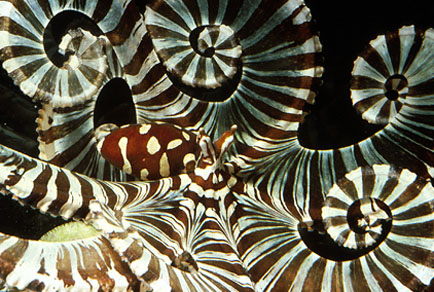Abstract
Wunderpus photogenicus n. gen. and n. sp. is a spectacular long-armed species that occurs on soft sediment habitats in shallow waters (typically less than 20 m deep) in Indo-Malayan waters. It is characterized by small eyes on elongate stalks, a long, conical papilla over each eye and a dramatic and fixed color pattern of white bars and spots over a brown-red background. The distribution of the species is centered in the Indo-Malayan Archipelago and extends from Vanuatu to Papua New Guinea, Indonesia and Malaysia, north to the Philippines. Animals typically emerge at dusk and dawn to forage in the twilight, primarily catching small crustaceans and fishes by flaring the arms and webs over patches of sand or coral rubble to trap enclosed (and typically buried) prey. The species also extends its arms into holes to probe for potential prey. The distinctive color pattern of this species is most pronounced when the octopus is disturbed or threatened by real or perceived attackers. It appears to be a warning display and may represent one of two scenarios: either 1) it warns that the octopus is directly toxic or venomous by nature or; 2) it represents impersonations of toxic or venomous creatures with similar color patterns which cooccur in the same habitat. The new genus and species is compared with, and distinguished from, other long-armed octopuses.

